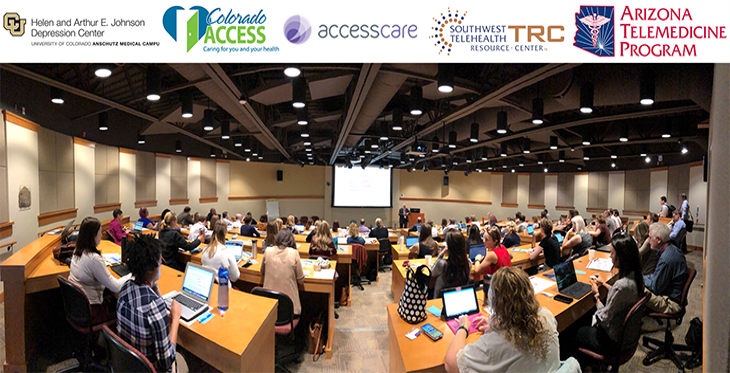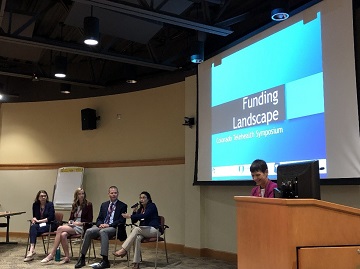
The Arizona Telemedicine Program (ATP) and the SWTRC have been conducting telemedicine training sessions for nearly 20 years and hosting regional telemedicine meetings for at least as long as well. Most have been within the state of Arizona, and although they have attracted attendees from throughout the Southwest region as well as the rest of the nation and world, we felt it’s time to expand our efforts and work more with our long-time partners in the region to promote telemedicine. To aid in this effort, the SWTRC received supplemental funding to our existing grant (as did all the TRCs) from HRSA (Health Resources and Services Administration) to co-host telehealth meetings in our designated regional states. First stop – CO!
For this meeting we worked closely with our long-time colleague Jay Shore, MD, FATA, Chief Medical Officer, AccessCare, Director of Telemedicine, Helen and Arthur E. Johnson Depression Center at the University of Colorado Anschutz Medical Campus and his team of telehealth experts. The meeting was co-sponsored by the ATP, SWTRC, Helen and Arthur E. Johnson Depression Center, Colorado Access and AccessCare and it was held on August 19th at the beautiful Nighthorse Campbell Building Auditorium on the University of Colorado Anschutz Medical Campus. If you have never had the opportunity to visit the Nighthorse Campbell facility, it houses the Centers for American Indian and Alaska Native Health (within the Colorado School of Public Health) and its design incorporates many Native American cultural elements and it truly an amazing and thought-provoking place to have a meeting. (http://www.ucdenver.edu/academics/colleges/PublicHealth/research/centers/CAIANH/about/Pages/Building.aspx). The auditorium nicely holds about 100 people and the room was filled to capacity with a waiting list!
The agenda for the day started out with an excellent and informative overview of the “Past, present, future of telemedicine” presented by Ronald Weinstein, MD founding Director of ATP and Co-Director of the SWTRC. Having inspired attendees about the potential and benefits of telemedicine, the next session was a panel on the ever-present question – what’s the funding landscape these days? Encouraging news about recent and hopefully future changes by Medicare (e.g., loosening up some antiquated restrictions like the rural requirement and expanding originating sites) was presented by Nancy Rowe Associate Director for Outreach & Public Policy (ATP, SWTRC). We then moved to funding at the state level (Medicaid) with presentations by Rob Bremer, PhD Vice President of Network Strategy, Integrated Care for Colorado Access talking about their offerings and Jessica Pekala, JD Policy Specialist at the CO Health Program Office talking about different telemedicine payment models and policies. Jacqueline Calderone, MD Associate Director of Primary Care Telepsychiatry at the Helen and Arthur E. Johnson Depression Center followed with a discussion of private payers, noting the important fact that telehealth parity does not always refer to parity in reimbursement. Attendees had a lot of great questions ranging from when it’s appropriate to charge the facility fee to direct to consumer options.

One of our key goals for all of our training and/or outreach sessions is to provide resources to help those just getting in telemedicine as well as those already there but looking to expand. Janet Major Associate Director of Education & Facilities (ATP, SWTRC) provided a wealth of information about overall resources from organizations like the American Telemedicine Association (ATA) plus those unique to the National Consortium of Telehealth Resources (https://www.telehealthresourcecenter.org/) and the SWTRC (https://southwesttrc.org/). I then discussed the process for creating and the various practice guidelines developed by the ATA and provided some solid metrics that people can use when evaluating their programs.
The program then shifted gears a bit and focused directly on telemedicine in CO with a particular emphasis on telemental health. Local experts Jay Shore, MD, Matt Mishkind, PhD Director of Operations for Military and Veteran Program for the Helen and Arthur E. Johnson Depression Center, Liz Mooney, PMP, MPA Director of Telemedicine for Colorado Access and George Roupas Manager, Telehealth Programs AccessCare quickly engaged the audience in a 2-part presentation. The first part provided a great overview of telehealth offerings from AccessCare, the Depression Center and Veterans and Veterans Families Telehealth, and the second was more of a panel format discussing operationalization, challenges, successes and barriers. The speakers’ hands-on, practical advice and information that has grown out of their daily use of telemedicine and interactions with patients in a wide variety of settings and backgrounds was clearly appreciated by the audience.
The attendees actually had some “homework” during the meeting – write down some of their key challenges and additional question so we could have an open discussion in the last session addressing telemental health access in CO. Three themes arose not only from the note cards, but throughout the day: the human element, getting started from square one and special situations. What the “human element”? Getting people on board – everyone from your CEO to billing and everyone in between – not just physicians – and don’t forget the patients. It’s also all about training and on more than one occasion it was noted by multiple people that doing some simulated sessions before setting someone free with patients is one of the best ways to prepare providers to have successful tele-encounters. We also talked about setting expectations (for everyone involved), tele-etiquette and cultural awareness, competencies and a variety of related topics.
Getting started is a bit different that getting people on board, but clearly encompasses that. A lot of times getting into telemedicine just seems so daunting that people just don’t know where to start. We talked about the basics – defining the need for telemedicine in your organizational setting, defining what is the goal of implementing telemedicine (don’t do it just because it’s cool and everyone else is doing it!), starting small rather than doing tele-everything, and choosing appropriate metrics for success before you start offering services. We talked about the various resources available, including funding options and sustainability and the fact that the return-on-investment will likely not be as quick as people think or hope – it can take a few years to reach the tipping point where the benefits outweigh the initial investment. The discussion around defining success was very interesting, noting often that sometimes benefits might need to be reframed. For example, everyone wants to save money but telemedicine by itself is not likely to make a huge profit. However, if you define the goal of telemedicine as to reduce no-show rates this will actually be reflected in your bottom line in the asset column since you don’t get paid for no-shows.
Finally the conversation touched on special or unique situations, with one of the interesting ones being how to get started when in private practice and you’re everything from provider to scheduler to biller. The advice really paralleled the prior topic of getting started overall. Start small and go with what you’re most comfortable with. In fact, start with your existing patient base, offering them the option of doing some of their visits via telemedicine before trying to expand your patient base by bringing in new patients with the telemedicine option. Once you have that experience under your belt then expand – and it might help to work with a marketer to promote your services.
In summary, we’d like to thank our local hosts for helping organize and run the meeting, help with the speakers and the invite lists – it was great working with them and seeing the impact the meeting had on attendees. Some of the comments from the evaluations highlight the fruits of this wonderful collaboration!
“Great resources. Really appreciate the coverage of all the elements which those of us working to develop tele-initiatives may not have or may not even be aware should be added to a newly forming tele-service.”
“Really great and informative. May reach out for specific issues with our region, but all in all really appreciate all you put into bringing us all this information.”
“Tremendous; thank you – hope you are able to make this an annual event!”
“Great array of speakers and information. Thank you.”


